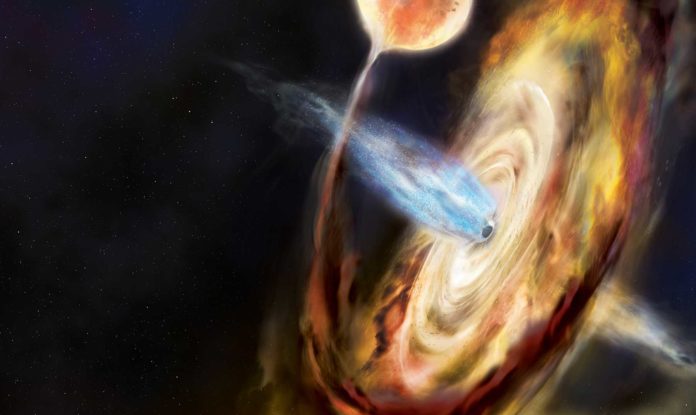Using NASA’s Neutron star Interior Composition Explorer (NICER), NASA scientists observed the environment surrounding a stellar-mass black hole that is 10 times the mass of the Sun.
Scientists detected X-ray light from the recently discovered black hole, called MAXI J1820+070 (J1820 for short), as it consumed material from a companion star. These X-rays formed ‘light echoes’ that reflected off the swirling gas near the black hole and revealed changes in the environment’s size and shape.
Erin Kara, an astrophysicist at the University of Maryland, College Park and NASA’s Goddard Space Flight Center in Greenbelt, Maryland said, “NICER has allowed us to measure light echoes closer to a stellar-mass black hole than ever before. Previously, these light echoes of the inner accretion disk were only seen in supermassive black holes, which are millions to billions of solar masses and undergo changes slowly.”
“Stellar black holes like J1820 have much lower masses and evolve much faster, so we can see changes play out on human timescales.”
Zaven Arzoumanian, the NICER science lead at Goddard and a co-author of the paper said, “NICER was designed to be sensitive enough to study faint, incredibly dense objects called neutron stars. We’re pleased with how useful it’s also proven in studying these very X-ray-bright stellar-mass black holes.”
A black hole can siphon gas from a companion star into a ring of a material called an accretion disk. Gravitational and magnetic forces warm the disk to millions of degrees, making it sufficiently hot to create X-rays at the internal parts of the circle, close to the black hole. Upheavals happen when a flimsiness in the circle makes a surge of gas push internal, around the black hole, similar to a torrential slide. The reasons for circle dangers are inadequately comprehended.
Above the disk is the corona, a region of subatomic particles around 1 billion degrees Celsius (1.8 billion degrees Fahrenheit) that glows in higher-energy X-rays. Many mysteries remain about the origin and evolution of the corona. Some theories suggest the structure could represent an early form of the high-speed particle jets these types of systems often emit.
Astrophysicists want to better understand how the inner edge of the accretion disk and the corona above it change in size and shape as a black hole accretes material from its companion star. If they can understand how and why these changes occur in stellar-mass black holes over a period of weeks, scientists could shed light on how supermassive black holes evolve over millions of years and how they affect the galaxies in which they reside.
One method used to chart those changes is called X-ray reverberation mapping, which uses X-ray reflections in much the same way sonar uses sound waves to map undersea terrain. Some X-rays from the corona travel straight toward us, while others light up the disk and reflect back at different energies and angles.
Over the plate is the crown, a district of subatomic particles around 1 billion degrees Celsius (1.8 billion degrees Fahrenheit) that sparkles in higher-vitality X-rays. Numerous riddles stay about the starting point and development of the crown. A few speculations propose the structure could speak to an early type of the fast molecule streams these sorts of frameworks regularly transmit.
Astrophysicists need to more readily see how the inward edge of the gradual addition circle and the crown above it change fit as a fiddle as a dark opening accumulates material from its buddy star. In the event that they can see how and why these progressions happen in outstanding mass dark gaps over time of weeks, researchers could reveal insight into how supermassive dark gaps advance more than a huge number of years and how they influence the systems in which they dwell.
As scientists examined NICER’s observations of J1820, they saw a decrease in the delay, or lag time, between the initial flare of X-rays coming directly from the corona and the flare’s echo off the disk, indicating that the X-rays traveled shorter and shorter distances before they were reflected. From 10,000 light-years away, they estimated that the corona contracted vertically from roughly 100 to 10 miles — that’s like seeing something the size of a blueberry shrink to something the size of a poppy seed at the distance of Pluto.
Co-author Jack Steiner, an astrophysicist at the Massachusetts Institute of Technology’s Kavli Institute for Astrophysics and Space Research in Cambridge said, “This is the first time that we’ve seen this kind of evidence that it’s the corona shrinking during this particular phase of outburst evolution. This is the first time that we’ve seen this kind of evidence that it’s the corona shrinking during this particular phase of outburst evolution.”
To confirm the decreased lag time was due to a change in the corona and not the disk, the researchers used a signal called the iron K line created when X-rays from the corona collide with iron atoms in the disk, causing them to fluoresce. Time runs slower in stronger gravitational fields and at higher velocities, as stated in Einstein’s theory of relativity. When the iron atoms closest to the black hole are bombarded by light from the core of the corona, the X-ray wavelengths they emit get stretched because time is moving slower for them than for the observer (in this case, NICER).
Co-author Philip Uttley, an astrophysicist at the University of Amsterdam said, “NICER’s observations of J1820 have taught us something new about stellar-mass black holes and about how we might use them as analogs for studying supermassive black holes and their effects on galaxy formation. We’ve seen four similar events in NICER’s first year, and it’s remarkable. It feels like we’re on the edge of a huge breakthrough in X-ray astronomy.”
A paper describing the findings appeared in the Jan. 10 issue of Nature and is available online.
